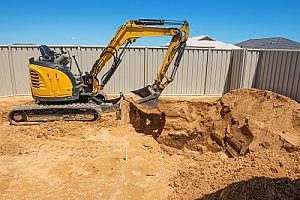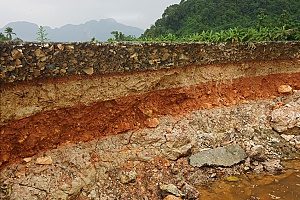 When it comes to construction and landscaping, land grading is more than just moving dirt around—it’s an essential step in preparing a site for various projects, from preventing water damage to laying the foundation for new structures or creating a garden.
When it comes to construction and landscaping, land grading is more than just moving dirt around—it’s an essential step in preparing a site for various projects, from preventing water damage to laying the foundation for new structures or creating a garden.
Because of this, understanding the different types of land grading is key to ensuring your project goes smoothly and meets its objectives.
In this article, we’ll break down these methods and their specific uses, giving you the knowledge to approach your next project confidently.
What Types of Land Grading Are There?
Every property is unique, with distinct characteristics in terms of soil composition, existing vegetation, and natural gradients. Consequently, land grading methods must be tailored to fit the specific requirements of each landscape.
Different grading techniques might be utilized and employed depending on the project’s nature and overall end goals.
Drainage Solutions
A fundamental aspect of any landscape endeavor, drainage is vital for the long-term health and maintenance of the terrain. The land is often graded with a slight slope to mitigate water pooling, erosion, and subsequent damage, which ensures that water doesn’t stagnate but flows in the intended direction, typically downhill, leading to a designated runoff point or stream.
In cases where the natural slope might not be enough or in particularly waterlogged areas, additional measures are taken. One common solution is the installation of drainage pipes beneath the ground, which effectively channel the water, redirecting it to specific drains or runoffs and preventing any potential water damage to the landscape or structures therein.
Excavation
Not all land grading projects involve merely redistributing the existing earth—sometimes, the land needs to be dug up to achieve the desired gradient. This process, known as excavation, requires creating depressions or holes in the landscape. It’s a vital step in construction, especially when laying down foundations for roads, buildings, or other significant structures.
The excavated material can either be relocated elsewhere on the site or removed entirely, depending on the project’s requirements and design. It’s a method that ensures stability and longevity, particularly for structures that require robust and deep foundations.
Topsoil Installation
The nature of the existing soil can sometimes pose challenges. For instance, in areas where the natural soil isn’t conducive for construction or landscaping due to its composition, lack of fertility, or insufficient volume, there’s a need for external intervention, and this is exactly where topsoil installation can be really beneficial to your project.
Importing topsoil not only aids in achieving the desired grading but also introduces a rich layer of earth conducive for plant growth. Topsoil, teeming with organic matter, offers a nourishing environment for vegetation, ensuring a green and vibrant landscape.
Furthermore, the visual appeal of a fresh layer of topsoil can enhance the overall appearance of a property, giving it a neater and much more refined look overall.
Surface Smoothing
 A cursory glance at a plot of land might give the impression of it being flat and even, but upon closer inspection, there could be minor irregularities, undulations, or rough patches. Such inconsistencies, though seemingly trivial, can become problematic, especially when lying down hardscapes like patios, driveways, or pathways.
A cursory glance at a plot of land might give the impression of it being flat and even, but upon closer inspection, there could be minor irregularities, undulations, or rough patches. Such inconsistencies, though seemingly trivial, can become problematic, especially when lying down hardscapes like patios, driveways, or pathways.
Surface smoothing is a grading technique employed to rectify these minor imperfections. It involves leveling the land, ensuring a uniformly flat surface, devoid of any bumps or depressions. The result is a flawless foundation that’s primed for any construction or landscaping project, ensuring both building durability and a greater aesthetic appeal.
Residential and Commercial Land Grading Services
Land grading is an essential element in the construction and landscaping industries, ensuring that both residential and commercial properties are primed for successful development.
These services cater to a wide range of needs, from preparing a site for new construction to enhancing the aesthetics and functionality of an existing landscape.
Demolition
Before starting a new project, it’s often necessary to clear the site of any existing structures or outdated elements. Expert demolition teams ensure that old buildings, housing components, or interior spaces are removed carefully and efficiently.
Using specialized tools and equipment, these professionals can dismantle structures, ensuring that desired elements are preserved and unwanted ones are removed. Once the demolition process is complete, the area is cleaned, making way for the next phase of construction or landscaping.
Site Preparation
Proper site preparation is a cornerstone of any successful construction project, and the first real step typically involves “rough staking,” which is marking the precise areas intended for development. While this can be done by the property owner, professionals bring expertise, ensuring that the placement of new structures optimally integrates with the site’s unique characteristics.
After staking, the site is cleared of obstructions such as trees, shrubs, and debris. If certain natural features are to be preserved, they’re identified during the staking phase. Then, once cleared, professionals begin rough grading, ensuring the land’s gradient is suitable for the project ahead.
Dirt Grading and Excavation
After the site is staked and cleared, excavation begins, which involves creating depressions or holes in the ground, especially when below-ground components like basements or pools are part of the plan. An essential principle in excavation is the “cut and fill” method, which aims to balance the amount of soil removed with the soil used to fill other areas—this equilibrium is cost-effective and efficient.
The dirt obtained from the excavation process is often used to grade the land, ensuring an even or desired slope. Proper grading is imperative as it dictates drainage patterns and provides a stable structure base. The process begins with rough grading to shape the land and culminates in final grading, fine-tuning the site’s contours to ensure optimal drainage and accommodate landscaping.
Erosion Control
 Soil erosion, especially during construction, is a significant concern for project managers. While it’s challenging to halt erosion entirely, especially due to natural factors like rain and water runoff, effective erosion control measures can significantly mitigate its impact.
Soil erosion, especially during construction, is a significant concern for project managers. While it’s challenging to halt erosion entirely, especially due to natural factors like rain and water runoff, effective erosion control measures can significantly mitigate its impact.
Implementing these kinds of measures during the construction phase helps to ensure that the site’s integrity and functionality are maintained over the long term. Proper erosion control protects the project’s foundation and surrounding landscape, ensuring that grading efforts aren’t negated over time.
Trust Dirt Connections for Premier Land Grading Services
Proper land grading is an indispensable step in both residential and commercial construction. It lays the groundwork for robust, long-lasting structures and vibrant landscapes. For those contemplating a project, the importance of choosing seasoned experts cannot be overstated.
If you’re poised to take the next step, consider partnering with a leader in the field—Dirt Connections. Residents of Virginia can reach out at 1-703-940-9949, while those in Maryland can dial 1-301-691-3215 to get started.
Alternatively, you can contact Dirt Connections online to explore their comprehensive suite of residential and commercial land grading services. Your vision deserves the expertise and dedication they bring to every project.
Summary

Dirt Connections was started with one goal in mind: providing quality residential and commercial construction services to clients on time and on budget. Reach out for more information on how we can support your next project.
For your convenience our estimates are free and by appointment. Call 703-940-9949 for a free estimate today!










































